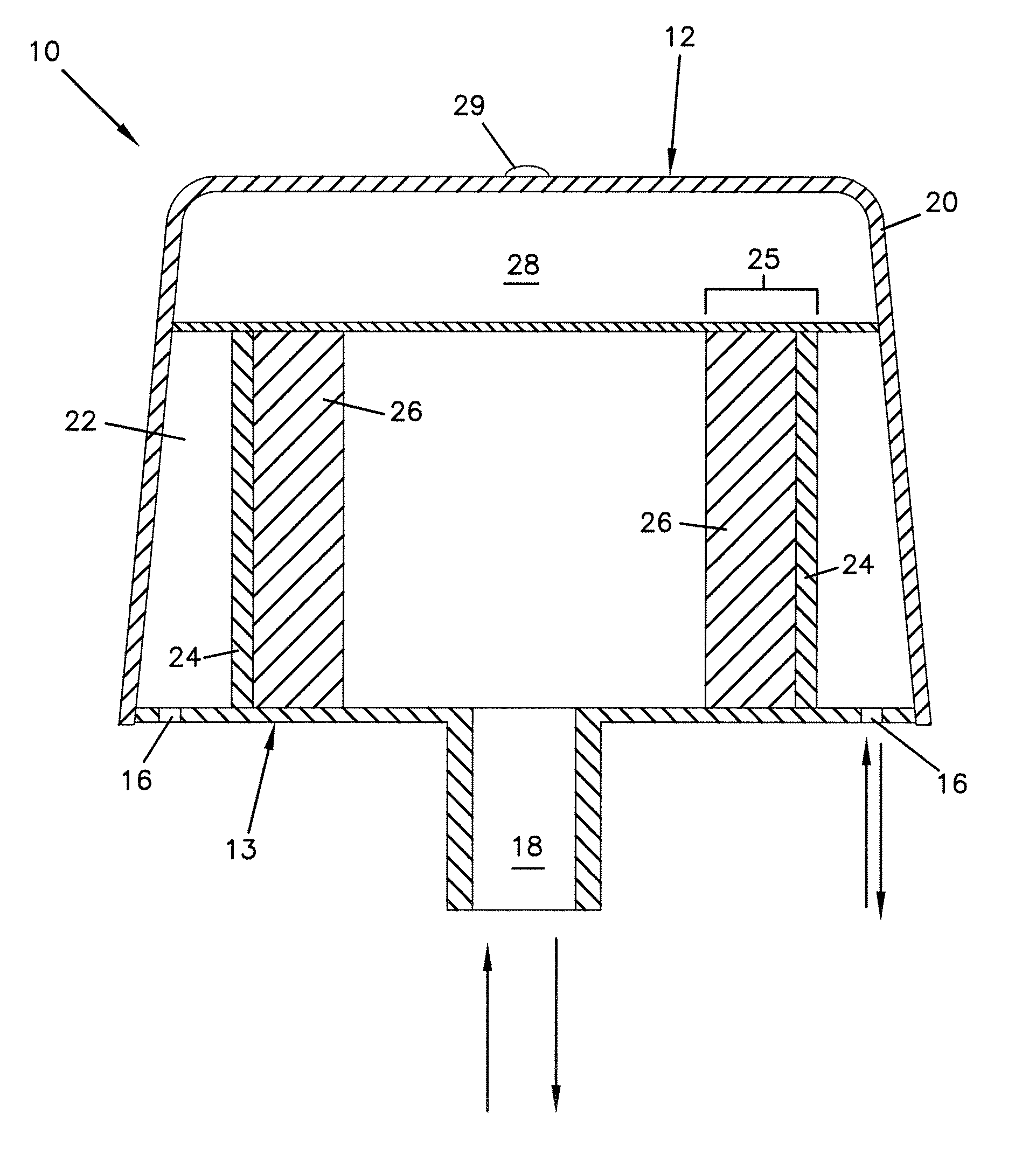Filter medium and breather filter structure
a filter medium and filter structure technology, applied in the field of filter medium and filter structure, can solve the problems of reducing efficiency, reducing permeability, and incorrect pore size, and achieve the effects of substantial efficiency, high capacity, and substantial flow ra
- Summary
- Abstract
- Description
- Claims
- Application Information
AI Technical Summary
Benefits of technology
Problems solved by technology
Method used
Image
Examples
example 9
[0112] Example 9, EX1051, is a sheet material useable for example, as a media phase in a filter and can be used in layers to provide useable efficiencies of overall filtration. The material will drain well and effectively, for example when used as a tubular media construction having a height of 4 inches −12 inches (100-300.5 mm). The media can be provided in multiple wrappings, to generate such a media pack. The media comprises a wet laid sheet made from a fiber mix as follows: 50% by wt. DuPont polyester bi-component 271 P cut to 6 mm length; 40% by wt. DuPont polyester 205 WSD, cut to 6 mm length; and 10% by wt. Owens Coming DS-9501-11W Advantex glass fibers, cut to 6 mm. The DuPont 271 P bi-component fiber is an average fiber diameter of about 14 microns. The DuPont polyester 205 WSD fiber has an average fiber diameter of about 12.4 microns. The Owens Corning DS-9501-11W has an average fiber diameter of about 11 microns. The material was made to a basis weight of about 40.4 lbs. / ...
example 10
[0113] Example 10, EX1050, was made from a fiber mixture comprising 50% by weight DuPont polyester bi-component 271 P cut to 6 mm length; and 50% by weight Lauscha B50R microfiber glass. The microfiber glass had lengths on the order of about 3-6 mm. Again, the DuPont polyester bi-component 271P had an average diameter of 14 microns. The Lauscha B50R had an average diameter of 1.6 microns and a d2 mean of 2.6 microns.
[0114] The sample was made to a basis weight of 38.3 lbs. / 3,000 square feet. The thickness of the media at 0.125 psi, 0.020 inches and at 0.563 psi was 0.017 inches. Thus the percent changed from 0.125 psi to 0.563 psi was 15%, i.e., 15% compressibility. At 1.5 psi, the sample had a thickness of 0.016 inches. The solidity of the material measured at 0.125 psi was 6.9%. The permeability of the material was about 204 feet / minute. The machine direction fold tensile was measured at 3.9 lbs / inch width. The calculated pore size X-Y direction was 18 microns. The DOP efficiency...
example 11
[0115] Example 11, EX 1221, is a sheet material useable for example, as a media phase in a filter and can be used in layers to provide usable efficiencies for overall filtration. The material will not drain as well as either example 9 or 10 but will exhibit much higher efficiency. It is useful for mist applications where load rate is lower and element construction allows for a pleated construction of higher pleat height, such as 10 inches. The media was made from a fiber mixture comprising 50% by weight DuPont polyester bi-component 271P cut to 6 mm length; and 12.5% by weight Lauscha B50R microfiber glass and 37.5% Lauscha B26R. The microfiber glass had lengths on the order of about 3-6 mm. Again, the DuPont polyester bi-component 271 P had an average diameter of 14 microns. The Lauscha B50R had an average diameter of 1.6 microns and a d2 mean of 2.6 microns.
[0116] The sample was made to a basis weight of 78.8 lbs. / 3,000 square feet. The thickness of the media at 0.125 psi, 0.050 ...
PUM
| Property | Measurement | Unit |
|---|---|---|
| length | aaaaa | aaaaa |
| diameter | aaaaa | aaaaa |
| diameter | aaaaa | aaaaa |
Abstract
Description
Claims
Application Information
 Login to View More
Login to View More - R&D
- Intellectual Property
- Life Sciences
- Materials
- Tech Scout
- Unparalleled Data Quality
- Higher Quality Content
- 60% Fewer Hallucinations
Browse by: Latest US Patents, China's latest patents, Technical Efficacy Thesaurus, Application Domain, Technology Topic, Popular Technical Reports.
© 2025 PatSnap. All rights reserved.Legal|Privacy policy|Modern Slavery Act Transparency Statement|Sitemap|About US| Contact US: help@patsnap.com



